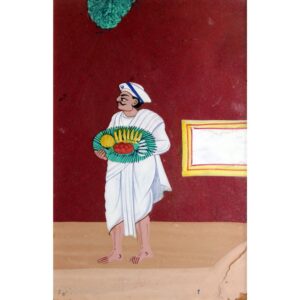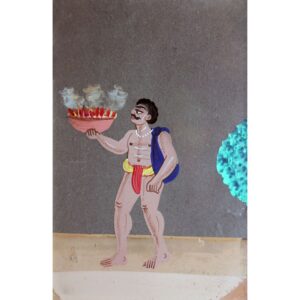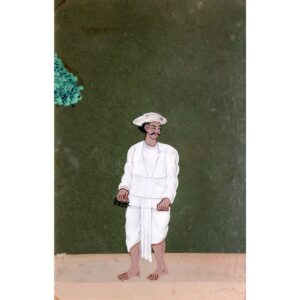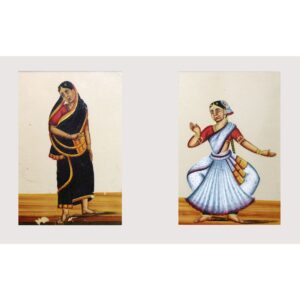Mica paintings featured a wide range of subject matter, including Hindu gods and goddesses, religious events, trades people and flora and fauna of the subcontinent. They were very popular around the middle of the 19th century, being produced in large numbers for the colonial tourist market: they imitated paintings on glass, which were popular in Europe at the time. Mica paintings are generally small, and painted in gouache on one side of very thin, flexible sheets. Mica is a transparent mineral which is found throughout south India and Bihar. The mica is formed between strata of granite, and the transparency of the material is a result of the heat and pressure created between layers of rock. Mica consists of many interlocking platelets, resulting in a laminar structure which can be split easily into thin sheets.The appeal of mica as a support for painting is due to its very smooth surface: the paint sits on it without sinking in, making the colours very intense. Mica is a very brittle substance, however, meaning that it is relatively rare to find examples in perfect condition.
Mica paintings were introduced in Murshidabad, capital of the Mughal province of Bengal and were available in plenty in the Chota Nagpur plateau. Local craftsmen who made ornamental lamps for the celebration of Muslim festivals knew the technique of mica painting which was then made on small rectangles of mica sheets. The British soon started patronizing these artists and many artists shifted to mica as their medium. Depiction of native characters and occupations became a Patna speciality. Some Patna artists set up family workshops and produced sets of mica paintings on a commercial scale, sold in packets of twelve, called Puria, sold for two rupees and ten annas. These sets became so popular that many of them were taken back as souvenirs.
Indian Painters in Banaras soon followed the trend of mica paintings set by Patna artists, but soon surpassed in both quality and variety. The Banaras artists improved upon the techniques and brought out packets of a dozen pictures relating to varied subjects. New features such as documentary style costume pictures with faces and background left blank. These paintings were sold in ornamental boxes with a painting on a lid.
By 1850s, a well established school of mica painting developed in Tiruchirappalli. Mica was brought from Kadapa in Andhra Pradesh and Madras. These paintings largely depicted Hindu deities, temple festivals, castes, and occupations. There are four bound volumes of mica paintings in the Victoria and Albert Museum, London, entitled “Trichonopoly Exploits” with an 1851 watermark.






